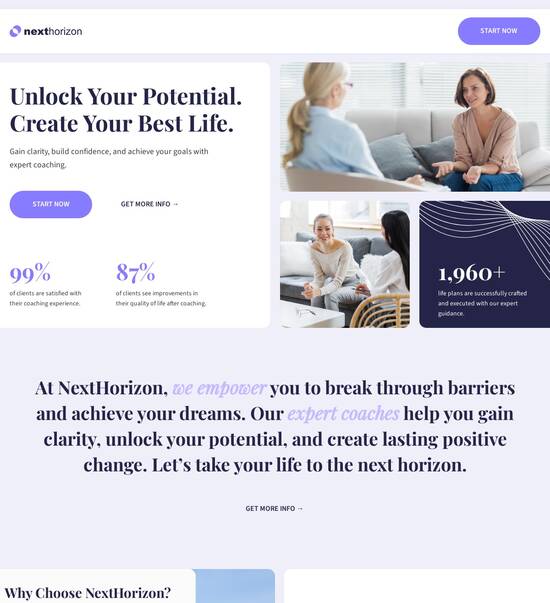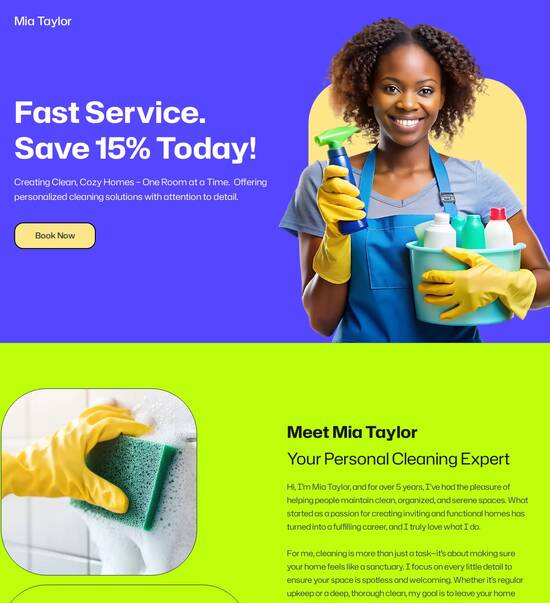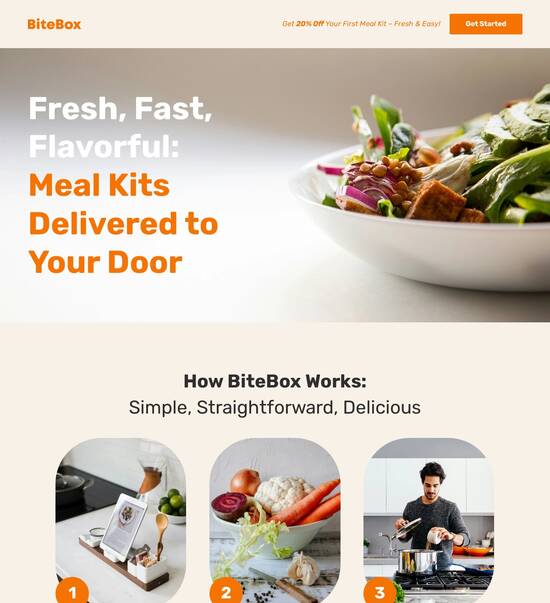
Attractive recipe sharing website template
Explore Similar TemplatesAbout template
Drive more leads with Instapage attractive recipe sharing website template built to maximize conversions. Easy customization - no designer or coding skills needed.
Recommended templates

Easy to build without coding
With the intuitive drag-and-drop builder, anyone on your team can create high-converting pages without any knowledge of code or design. Make enhancements to your landing page with custom widgets using Javascript, HTML/CSS, or third-party scripts.

Multiple layouts for any industry and goal
Select from 500+ landing page layouts built to boost conversions across industry-specific scenarios. Customize them by adjusting fonts, adding images, and generating on-brand content with the AI assistant. Quickly scale with Instablocks® and Global Blocks that you can save, reuse, and update globally.

Loads fast and looks polished on any device
Every template is responsive, which means they present professionally on any device and load blazingly fast with our Thor Render Engine. You can also power them up with Google AMP technology to deliver an unparalleled mobile experience and drive higher conversions.

Robust analytics & experimentation
Get real-time updates and reporting across all your devices, showing the number of visitors, conversions, cost-per-visitor, and cost-per-lead. Launch AI-powered experiments, run A/B tests, and use heatmaps to analyze user behavior, then optimize your landing page to maximize conversions.







Easy to build without coding
With the intuitive drag-and-drop builder, anyone on your team can create high-converting pages without any knowledge of code or design. Make enhancements to your landing page with custom widgets using Javascript, HTML/CSS, or third-party scripts.
Multiple layouts for any industry and goal
Select from 500+ landing page layouts built to boost conversions across industry-specific scenarios. Customize them by adjusting fonts, adding images, and generating on-brand content with the AI assistant. Quickly scale with Instablocks® and Global Blocks that you can save, reuse, and update globally.
Loads fast and looks polished on any device
Every template is responsive, which means they present professionally on any device and load blazingly fast with our Thor Render Engine.
Robust analytics & experimentation
Get real-time updates and reporting across all your devices, showing the number of visitors, conversions, cost-per-visitor, and cost-per-lead. Launch AI-powered experiments, run A/B tests, and use heatmaps to analyze user behavior, then optimize your landing page to maximize conversions.
All the features you need to build recipe website templates
Explore more featuresLearn how to build cooking website templates
Frequently asked questions about recipes website template
Leading the way in building high-performing landing pages





An effective landing page and CRO platform
Maximizing ROI on your digital marketing campaigns requires powerful tools, and Instapage stands out as an industry leader in landing page creation and conversion rate optimization. This guide will walk you through the essential steps to harness the full potential of Instapage to create high-converting landing pages that cater to diverse audiences across various sectors, such as business services, education, and financial services.
Understanding the basics of landing pages
Before diving into the features of Instapage, it’s crucial to understand what a landing page is. A landing page focuses on a single goal, often tied to specific outreach campaigns, designed to drive conversions. Using quality templates as your foundation, you can adapt these landing pages to target your ideal audience, whether it's tech enthusiasts or government agencies.
- What is a landing page? - A dedicated webpage created specifically for a marketing campaign, aimed at guiding visitors toward a single action.
- Why are landing pages important? - They help in focusing visitors' attention, increasing the chances of conversions.
- How does Instapage simplify landing page creation? - With over 100 pre-designed templates and drag-and-drop capabilities, you can launch original pages quickly, tailored to your audience.
Step 1: Designing your landing page
The first step in creating an effective landing page on Instapage is accessing its extensive library of customizable templates. With these pre-built elements, you can showcase your unique value proposition while ensuring a seamless user experience.
- Choose a template aligning with your campaign goals - Select from categories suited for various industries and marketing purposes.
- Customize your template - Use simple editing tools to modify text, images, and calls-to-action (CTAs) to align with your brand voice.
- Incorporate lead generation forms - Add intuitive lead capture elements to effectively convert visitors into leads.
Step 2: Optimize for conversions
Once your landing page is designed, the next step is optimization. Instapage provides built-in experimentation features that help you understand user behavior, allowing you to refine your page for maximum effectiveness.
- Utilize heatmaps - Analyze where users click and scroll to adjust your layout and content placement.
- Conduct A/B testing - Compare two versions of your page to gauge which performs better in terms of conversion rates.
- Monitor performance metrics - Use the analytics dashboard to track page performance and adapt strategies as needed.
Step 3: Personalize user experience
Personalization plays a key role in improving conversion rates. Instapage’s dynamic text replacement feature allows you to customize content according to user data, creating tailored experiences for visitors based on their interests and behaviors.
- Dynamic text replacement - Automatically change certain text elements on your landing page based on search queries or audience segments.
- AdMaps integration - Align specific ads with unique landing pages to maintain consistency and relevance.
- Utilize audience-level metrics - Track these personalized experiences to measure their effectiveness.
In conclusion, Instapage enables marketers to efficiently create and optimize high-converting landing pages tailored to various audiences. By following these steps, you can maximize your marketing results and ultimately achieve a higher ROI.
Ready to elevate your marketing strategy? Explore the capabilities of Instapage today and start designing your high-performing landing pages!
Exploring attractive recipe sharing website templates: A guide to elevated culinary experiences
The emotional connection: Understanding user cravings for the perfect recipe
To create an effective recipe sharing website, it’s crucial to connect with user emotions and understand their intentions. Whether users are searching for an exotic dish or a comforting family meal, their experiences in the kitchen greatly influence their happiness and satisfaction. By recognizing what drives users, we can craft a platform that truly caters to their cravings.
Identifying user intentions is fundamental to making a recipe sharing website appealing. Users often look for new flavors that excite their palates or seek healthy options to support their wellness journeys. Additionally, they want streamlined solutions that simplify meal preparation, helping them save time and reduce stress in the kitchen.
Emphasizing occasion-based recipes also adds to user engagement. Turning everyday meals into culinary adventures can enhance both daily life and festive celebrations. Furthermore, catering to dietary restrictions is increasingly important as more users seek recipes that fit their specific nutritional needs.
Structuring a recipe template: Features that matter
Designing a recipe template involves a myriad of critical elements that attract users and keep them coming back for more. Essential components must be established to form the backbone of an effective recipe sharing platform. Structuring the presentation of each recipe significantly influences user experience and retention.
Title: Catchy and descriptive names draw users in and help them remember the recipe.
Ingredients list: A clear and organized presentation of ingredients helps users easily assess how to prepare the meal.
Instructions: Step-by-step clarity is key for users to follow along easily and successfully.
Cooking time: Quick reference for busy users enables them to plan their meals effectively.
Nutrition facts: Providing health-conscious insights further engages users who are mindful of their dietary choices.
In addition to these essential components, enhanced features can significantly boost engagement. Interactive elements, such as timers and ingredient calculators, create a more intuitive experience. Providing personal notes sections allows users to customize their cooking process, while social media sharing options broaden the reach of recipes beyond the website.
User experience: Designing an intuitive interface
A seamless user experience is vital to the success of a recipe sharing website. This begins with navigability and ease of use, where streamlined menu structures allow users to explore recipes effortlessly. A well-designed search function based on cravings, occasions, or dietary needs further enhances the user’s ability to find suitable options quickly.
Another essential aspect of user experience is mobile responsiveness. Given today’s fast-paced lifestyle, templates optimized for on-the-go access make a significant impact in capturing and retaining users. Touch-friendly interactions ensure that mobile users can easily navigate the site, leading to higher engagement and satisfaction.
Finally, visual appeal cannot be overlooked. High-quality images significantly influence users' decisions, as fully captured visuals of delicious dishes can prompt immediate cravings. In addition, employing appropriate color schemes that reflect the brand identity enhances user interaction, making the website not just functional but also visually appealing.
Customization capabilities: Building a unique brand identity
When it comes to recipe sharing website templates, customization capabilities play a pivotal role in fostering a unique brand identity. Users appreciate being able to personalize their experience, and templates should allow for aesthetic tailoring to resonate with specific demographics. This could include elements such as color schemes and font choices that reflect the essence of the culinary brand.
Integrating logos and cohesive visual branding across templates strengthens recognition among users. Dynamic content layouts that facilitate variability in template structures tailor the user experience for different cuisines or occasions, leading to a more engaging site. Flexible modules can accommodate user-generated content and feedback, fostering a sense of community.
Community engagement: Fostering user interaction and connection
Communities within recipe sharing websites can form vibrant spaces for interaction. Implementing comment systems and ratings enables users to provide feedback and share their experiences. This feedback loop not only improves overall quality but also encourages collaboration, as users contribute their own recipes and culinary tips, enriching the website's content.
Incorporating social sharing features is vital for boosting visibility. When users share their favorite recipes on platforms such as Instagram or Pinterest, it draws new users to the website. Additionally, leveraging affiliate links and partnerships with food bloggers can create mutually beneficial relationships that extend the reach and influence of the recipe-sharing platform.
Advanced functionalities to elevate user experience
As users become increasingly discerning in their expectations, introducing advanced functionalities into recipe sharing templates can significantly enhance the user experience. Features like search filters and advanced sorting mechanisms allow users to explore recipes tailored to their dietary preferences, be it vegan, gluten-free, or another niche. Seasonal searches based on current cravings also keep the content fresh and relevant.
Integrating tools that assist with meal planning further enriches the user experience. Features enabling users to save, plan, and organize their meals streamline the cooking process. Automatic shopping list generation from selected recipes provides added convenience, ensuring that users have all necessary ingredients on hand.
Analytics and optimization: Tracking user engagement and preferences
To ensure continued growth, utilizing data analytics becomes critical for recipe sharing platforms. Monitoring which recipes gain the most traction and analyzing trending searches allow website administrators to fine-tune content strategies. Adjustments based on user behavior insights help tailor the website to better meet audience expectations.
A/B testing templates provide another method for optimizing user engagement. By experimenting with different designs and analyzing user interactions, website administrators can implement iterative improvements that resonate more deeply with their audience. Feedback received during this testing phase can direct changes that fruitfully influence the overall user experience.
Monetization strategies within recipe sharing platforms
Monetization is an essential consideration for recipe sharing websites. Different strategies can be explored to generate revenue while maintaining a user-friendly experience. Sponsored content and partnerships with food brands serve as a valuable means of income without detracting from the user experience.
Subscription models offer another lucrative avenue, enabling users to access premium content or exclusive recipes. This model not only provides a steady revenue stream but also cultivates a dedicated community of users interested in deeper culinary exploration. Similarly, affiliate marketing opportunities—where users are directed to cooking tools, ingredients, or specialty dietary products through affiliate links—can enhance revenue while providing added value to users.
Real-life examples: Successful recipe sharing websites and their template innovations
Learning from the success of leading recipe sharing websites offers valuable insights into effective template innovations. Reviewing case studies of these platforms reveals user-friendly design elements that facilitate easy navigation and engagement. For instance, assessing how highly rated sites integrate feedback systems and community contributions can inspire enhancements in our own approach.
Additionally, investigating innovative features that stand out in the culinary space may offer lessons for implementation. Recognizing unique functionalities can illuminate pathways to greater user satisfaction, providing a competitive edge in the ever-growing culinary digital world.
Future trends: The evolution of recipe sharing templates
The landscape of recipe sharing websites is continually evolving, and several predicted innovations could shape user experiences going forward. For instance, integrating artificial intelligence to provide personalized recipe suggestions might enhance user satisfaction by ensuring that users only encounter dishes that align with their specific tastes and preferences.
Moreover, advancements in technology may facilitate virtual cooking classes or demonstrations through templates, engaging users on a deeper level. With increasing emphasis on sustainability, users may also expect to see more recipes highlighting ethical sourcing and environmentally friendly cooking practices. Keeping these trends in mind will position your recipe sharing website for success as user expectations grow.
Ready to skyrocket conversions?
Supercharge your ad campaigns with high-performing landing pages
Get started














